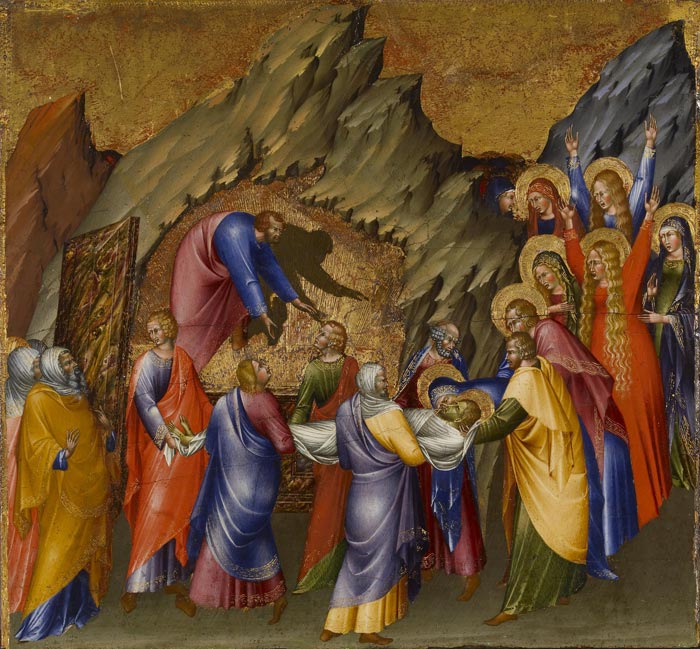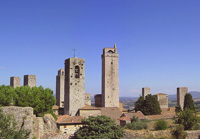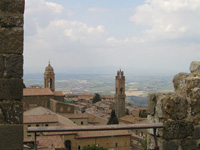 |
Giovanni di Paolo, The Descent from the Cross (detail), 1426, tempera and gold leaf on panel, The Walters Art Museum, Baltimor e |
Giovanni di Paolo | The Malavolti altarpiece |
| The city-state of Siena, a large Italian hill town some 70km south of Florence, had its golden age in the early trecentro under the artistic genius of Duccio (c.1260–1319) and Simone Martini (c.1285–1344). They developed a rich courtly style dependent on a dancing line rather than the naturalistic concerns of Florentine painters such as Giotto. Giovanni di Paolo’s altarpieces payed homage to this legacy, to which he was bound by a continuous workshop tradition. The artist seems to have been enormously popular in his own lifetime and over two hundred generally-accepted autograph works survive.[1] |
Giovanni di Paolo was an independent artist who managed to thrive in a Siena which was on the one hand conservative and on the other responsive to such inventive minds as Sassetta and the Osservanza Master. Like these artists, Giovanni di Paolo had remarkable narrative gifts as an artist as is clear from such masterpieces as The Life of John the Baptist (Art Institute of Chicago), The Expulsion of Adam and Eve from the Garden of Eden (Robert Lehman Collection, Metropolitan Museum, New York) and the Paradise (Metropolitan Museum, New York). His early training seems to have included contact with Lombard artists (his earliest patron was the Lombard Anna Castiglione a relative of Cardinal Castiglione Branda, patron of Vecchietta) and probably French artists too. He could, for example, have known the Limbourg brothers, the Franco-Flemish illuminators who were in Siena in 1413. Certainly the nervous, staccato quality of line that distinguishes his work from that of his Sienese contemporaries betrays an assimilation of Lombard and French Gothic forms. By the mid 1420s Giovanni di Paolo's career was flourishing and from that period come the Pecci and Branchini altarpieces (Pinacoteca Nazionale, Siena and Norton Simon Museum, San Marino) which both show the influence of Gentile da Fabriano who had painted a (now lost) altarpiece in 1425/6 for the Sienese Notaries Guild.
|
| The original Malavolti polyptych is Giovanni’s earliest known altarpiece, painted in 1426 when he was twenty-three, for the large church of San Domenico in Siena. Throughout his career he worked for the Dominican Order and its austerity may have encouraged his lifelong path toward an ever more mystical expressionism.
This early masterpieces by Giovanni di Paolo was originally part of an altarpiece in the chapel of the Malavolti family in the church of San Domenico in Siena. The main altar panel, dated 1426 and depicting the Virgin and Child flanked by saints, is in Italy. The predella panels show, chronologically, the Resurrection of Lazarus, the Way to Calvary, the Descent from the Cross, and the Entombment. Originally, an image of the Crucifixion (now in Germany) would have been in the center. Throughout his career, Giovanni di Paolo referred to the pictorial tradition of his native Siena that was rooted in Byzantine art and is characterized by, in particular, the gold ground and the stylized rock formations. In this altarpiece, its intact state rare for works from this period, the enthroned Virgin Mary, surrounded by angels, holds up the Christ Child to be worshiped. A monk, probably the donor of the painting, kneels below in prayer. The central panel is flanked by two side panels depicting the bishop St. Nicholas of Bari on the left and St. Galganus on the right. The latter is being instructed by the archangel Gabriel where to build his hermitage on Mount Siepi (in central Italy), and he thrusts his sword into the rock. St. Dominic, above, and St. Bartholomew, below, are represented on the left panel, and on the right panel is St. Francis of Assisi above St. John the Baptist. In the three pinnacles, Christ is framed by the archangel Gabriel and the Virgin of the Annunciation. The original Malavolti polyptych is Giovanni’s earliest known altarpiece, painted in 1426 when he was twenty-three, for the large church of San Domenico in Siena. Throughout his career he worked for the Dominican Order and its austerity may have encouraged his lifelong path toward an ever more mystical expressionism. In The Entombment, the shadow points up Nicodemus as the key figure who gave up his tomb for the burial of Jesus. This unusual act of charity may be a reflection of the Malavolti family’s commission of the altarpiece, and their relationship to the mendicant order. five predella panels from the Malavolti family altarpiece. Four are in the Walters Art Museum in Baltimore. The fifth and central panel, which I have seen only in black and white reproduction, The Crucifixion, is in the Lindenau Museum in Altenburg in Germany. |
|
|
 |
||
Giovanni di Paolo, The Resurrection of Lazarus, 1426, tempera and gold leaf on panel, The Walters Art Museum, Baltimore |
||
| The Resurrection of Lazarus
This is one of four early masterpieces by Giovanni di Paolo in the Walters. It was originally part of a predella (paintings on the base of an altarpiece) in the chapel of the Malavolti family in the church of San Domenico in Siena. The main altar panel, dated 1426 and depicting the Virgin and Child flanked by saints, is in Italy. The predella panels show, chronologically, the Resurrection of Lazarus, the Way to Calvary, the Descent from the Cross, and the Entombment. Originally, an image of the Crucifixion (now in Germany) would have been in the center. The resurrection of Lazarus was considered a model for the Resurrection of Christ, and the first panel thereby indicates what will happen after the Entombment. The scenes from Christ's Passion emphasize his humanity through his sufferings. Throughout his career, Giovanni di Paolo referred to the pictorial tradition of his native Siena that was rooted in Byzantine art and is characterized by, in particular, the gold ground and the stylized rock formations.(4)
|
||
 |
||
Giovanni di Paolo, The Way to Calvary, 1426, tempera and gold leaf on panel, The Walters Art Museum, Baltimore |
||
 |
||
Giovanni di Paolo, Crucifixion, 1426, tempera and gold leaf on panel, Altenburg, Lindenau Museum |
||
 |
||
Giovanni di Paolo, The Descent from the Cross, 1426, tempera and gold leaf on panel, The Walters Art Museum, Baltimore |
||
 |
||
Giovanni di Paolo, The Entombment, 1426, tempera and gold leaf on panel, The Walters Art Museum, Baltimore |
||
| In The Entombment, the shadow points up Nicodemus as the key figure who gave up his tomb for the burial of Jesus. This unusual act of charity may be a reflection of the Malavolti family’s commission of the altarpiece, and their relationship to the mendicant order. | ||
|
Giovanni di Paolo – also known as Giovanni di Paolo di Grazia – was born in Siena, probably towards the end of the fourteenth century. Although his training is not recorded, it is likely that he had early Lombard patrons, and was influenced by Lombardian book illumination. His first recorded commission was in 1417 for a Book of Hours, and Giovanni executed both illuminations and panel paintings throughout his career. In 1420 he was paid for two important, now untraced, paintings for the convent at San Domenico and for the monastery of St Marta in Siena. The first work securely attributed to him is the Triumph of Venus 1421 (Louvre, Paris).
|
||||
Museum on Exhibition http://www.rinascimento.terresiena.it/renaissance/arti_siena_primo_rinascimento_mostra.en.html |
||||
|
||||
Podere Santa Pia |
Podere Santa Pia, garden view, April |
|||
 |
 |
|||
| The towers of San Gimignano | Montalcino
|
Siena, Duomo |
||






